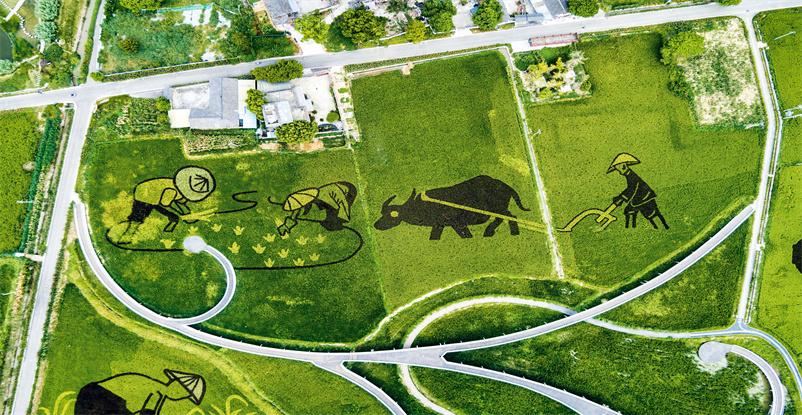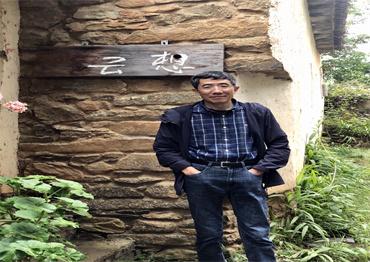n October 8, China’s agricultural authorities released the list of 100 counties to be built into models for rural revitalization, part of a new project that kicked off in August that aims to establish demonstration counties, towns and villages to further promote rural revitalization in a wider scope in the country, in response to State Council guidelines issued in January 2022. Provincial agricultural departments will select 1,000 demonstration towns and 10,000 model villages as showcases for the flagship policy.
Rural revitalization has topped the government’s agenda since 2017, when Chinese President Xi Jinping introduced the Rural Revitalization Strategy during the 19th National Congress of the Communist Party of China. It was aimed at consolidating the achievements of the campaign to eradicate absolute poverty and close the rural-urban gap. It included policies to encourage modern farming and rural industries, and measures and reforms in infrastructure improvement, living environment improvement, and training. Pilot projects are in full swing as places capitalize on their existing advantages.
Since 2015, Li Xiaoyun, executive vice dean of China Agriculture University’s Rural Revitalization Research Institution, and his team have been exploring paths to rural revitalization in Yunnan and other provinces. They have successfully guided around 20 villages onto a path where commercial activities rather than farming alone provide incomes by cultivating new business models and integrating rural-urban development. In an interview with NewsChina, Li talked about how to empower rural dwellers and the role urban areas have in rural revitalization.
NewsChina: Why is rural revitalization so important in China?
Li Xiaoyun: The essence of rural revitalization is modernization. In China, modernization did not evolve naturally like in the West. It learned from and tried to catch up with the West over a much shorter period, but rural areas failed to develop at the same time as urban areas. For a long time, the countryside only provided essential production for the urbanization and industrialization that started in the 1950s and was prioritized, causing capital and brain drain from the countryside. In this situation, the faster urbanization and industrialization proceeded, the quicker the countryside declined. The drastic change resulted in tremendous social and economic disorder and problems, such as villages where there are only women or children left behind by their parents, and these need to be urgently addressed.
Rural revitalization is an important component of China’s overall strategic goal of realizing basic modernization by 2035 and modernization in all aspects by 2050. Building a modern country does not allow for the coexistence of an advanced industrial urban society and underdeveloped rural areas. The modernization of the countryside, farming and farmers is, of necessity, part of the process. The goal of rural revitalization is to modernize rural areas across China.
In the past, the countryside was passively involved in modernization. Now it needs to play a more active role. But it can’t develop on its own, so the government needs to step in and invest capital and talent, alleviating and eradicating poverty.
Rural revitalization and poverty alleviation are essentially no different. Poverty alleviation is the primary stage of rural revitalization in impoverished regions, while rural revitalization could be called an upgraded version of poverty alleviation.
NC: What is rural revitalization trying to achieve?
LX: Actually, it has three core goals according to its three core social functions. First, rural areas will have to continue to provide agricultural produce. Now many farmers do not want to do farm work with low returns, a situation that needs to change. Second, maintaining ecological and environmental protection and preventing environmental deterioration. Last, China’s traditional farming culture needs to be preserved. All these three functions need to be actively pushed for rural revitalization [to succeed].
This means producing a new type of countryside. To do this, it must first have diverse industries and business models, which means it will no longer just be for producing agricultural products. Instead, it will be multi-functional. For example, it should include primary, secondary and tertiary industries. Traditional industries and processing industries could move to rural areas, too.
Next, farming practices need to be modernized. Modern farms, smart farming and even unmanned farms will replace old methods that rely on manual labor. On some modern farms, farmers use drones to spray pesticides or do other types of work. This can really improve labor and soil productivity. Large-scale planting will be just one way. Extending the industrial chain of planting and integrating planting into other industries like tourism [for things like fruit picking or photography] will be a tool too. Besides, rural revitalization needs to promote the modernization of small farmers who make up the bulk of Chinese farmers. Also, people living in rural areas will not only be left-behind children, women and the elderly like before. There will be new farmers with knowledge and technology who can operate [new] rural industries.
NC: What are the essentials to achieve rural revitalization? What role can urban areas play?
LX: Steady economic growth and promotion of new urbanization (a plan launched in 2014 emphasizing urban-rural integration) that integrates villages, towns and cities in development are essential. They are the basic conditions for realizing rural revitalization.
The countryside is in decline because of the constant draining of talent, capital and social culture. It requires investment to restore economic function and attract production factors back, and restore its economic and social value. This needs robust national economic growth as backing.
Realizing rural revitalization does not mean simply building a few villages or relying on the rural area itself. It requires the government to instill investment and channel the drivers of urban development into rural areas. The latter means developing industries and new business models according to urban needs and make urbanization and industrialization a driving force to stimulate rural development. It is impossible for rural areas to develop without being energized by urban areas.
The ratio of the rural population to agricultural output is imbalanced. We have around 23 percent of the population engaged in farming, but they produce only 7 percent of GDP. To modernize and increase per capita income, more people need to leave the countryside for non-farming jobs. This will leave room for large-scale farming too.
In this sense, we need to continue to promote urbanization. Rural revitalization will have to coincide with new urbanization, particularly county-centered urbanization.
Integrating production factors between rural and urban areas is essential too, as stressed in policies about rural-urban integration. When all the factors fuse and flow freely between rural and urban areas, the urban-rural gap will reduce.
Last but not least, we need to change the strategic mindset about rural development, turning from previously ignoring it to promoting the modernization of rural areas. I believe we are on the right path.
NC: So rural revitalization does not mean keeping farmers in villages?
LX: No. Some will stay and some will leave. Those interested in farming will stay. The countryside will shrink. Industrialization, urbanization and modernization are the trend.
Rural revitalization tries to keep the countryside, not the farmers. We will reproduce new villages, new farmers and new agriculture. In this way, rural areas are modernized and able to survive. New farmers will engage in various business models or production. Traditional farmers will be part of the past.
Besides, rural revitalization doesn’t mean developing every village. We have over two million villages and it’s impossible to develop them all. Villages that have no development potential will wane. Rural revitalization means many villages will vanish.
NC: Based on your practices, how do we carry out rural construction and cultivate new business models to help farmers get jobs and increase their incomes?
LX: Rural construction is not simply building infrastructure in the countryside. It’s about how to activate the economic and social functions of the countryside. Rural industries are essential. The government’s poverty alleviation efforts in earlier years already laid a foundation for developing rural industries. In promoting rural revitalization, we should focus on creating new business models and building a new countryside.
Since 2015, my team and I have explored effective paths for rural construction in some villages of Yunnan Province in Mengla County, Kunming, as well as Zhaotong, Linchang, Qujing and so on. The core idea is to cultivate new business models that increase both farmers’ incomes and the collective economy.
For example, Damiao Village was an impoverished village halfway up a hill. After the government improved the road, water supply and sewage treatment, we assisted villagers to build their own parking lot, cafe, restaurants and visitor centers and improve the environment for tourism. Since it started up in June, the village tourism company earned 900,000 yuan (US$125,460) within three months.
Rural construction is not about building beautiful villages. It needs to adapt and link with urban demand to grow its own development engine.
Of course, the situation varies in different places, so it’s not realistic for one place to just copy another. But the general experience we have drawn from pilot villages in Yunnan, like making farmers the key factor in rural revitalization, developing new business models, cultivating management professionals for village businesses and activating unused assets, may be of referential value to other places.
NC: Why should farmers be at the center of rural revitalization?
LX: First, the government needs to play the leading role in rural construction, as the countryside is too weak to invest in infrastructure and lay the foundations for rural revitalization. Farmers don’t really know how to get started. The government could invest in a pilot area for certain business to set examples. But it can’t get involved in specific businesses; they have to rely on the farmers.
It is important first to build a core pilot area, even in a village, and then gradually expand construction. We carried out experiments in many Yunnan villages this way. Once the demonstration area succeeds, it will motivate villagers and social forces to take part. Farmers are the owners of villages. The government lets them see the benefits first before guiding them to be the primary drivers of rural revitalization.
Policies stress making farmers the center of rural revitalization. This means farmers should be both the drivers and beneficiaries of their achievements. In designing industries or bringing in projects, the interests and incomes of farmers should be prioritized.
Following this rationale, in Damiao Village we suggested farmers who are also construction workers take charge instead of bringing in outside hires. So the farmers earned money for building their own village. After the village was ready to start opening businesses, we suggested the local government find teachers to train residents to operate cafes, shops, restaurants and hotels instead of handing it over to a company. Otherwise, the whole thing would have little connection with the farmers. Training residents to do business and instilling in them an awareness of a service culture and modern thinking is very hard. But it’s worthwhile in the long run.
In some places, I saw farmers rent out their land to business owners. But their incomes didn’t increase that much. The farmers only rent out their land and work for the companies, but they don’t learn skills like how to manage or operate a business. Their capabilities do not improve and they fail at modernizing. But I believe farmers should be the drivers of industrial development.
Of course, getting farmers on the path to modernization is challenging. It is probably the biggest challenge in rural revitalization. We can only address the problem gradually while pushing forward modernization. It takes time.
NC: Talent shortages are an enormous challenge. How do we address this problem?
LX: The lack of talented people who can turn countryside resources into industries is a core problem in developing rural areas. Capable brains are scarce in most villages. Young people prefer working in cities. It’s a fact we must face. Like enterprises in cities, rural revitalization requires many professional managers too. That’s why government policies and many places are paying increased attention to professionals in rural management.
In 2018, after villagers in a place called Hebian started their own cooperative, the problem was finding who could run the business. The farmers didn’t know how to run a modern business. Then I realized we needed professionals to help them. We chose several young villagers as the CEO, CFO and CTO. These young people started from scratch and needed long-term training. The process was rather hard. In 2019, the pilot village of Anning, Yunnan, employed a college graduate as its cooperative’s general manager, as we suggested. We applied this experience to other pilot sites in which they invited us to provide guidance.
These rural managers actually face rather complicated situations in villages as a bridge between modern and traditional societies, so they have to be very capable. But there is no mechanism for training them. In November 2021, China Agriculture University, in cooperation with [tech company] Tencent, launched a training plan to bring on countryside managers. We targeted college students and young people from villages. After a year’s training, many are becoming important elements of running village businesses. But this is just an exploration of a training mechanism for rural managers and isn’t expected to provide enough talent for rural development.
In a word, simply persuading young people to go to rural areas is not the solution. If they don’t take the job in the countryside seriously or don’t know how to do it, they will burden farmers, not help them. As new business models take root in rural areas, we need to foster many young people who know how to run a business and connect with markets. And to ensure they stay, there must be thriving businesses, effective governance, good pay and other policies that appeal to the young in rural areas.
Of course, managers are just one example of the professionals we need. The job needs to be done together with talent cultivation for countryside governance, entrepreneurs and others to really solve the shortage.

 Old Version
Old Version


